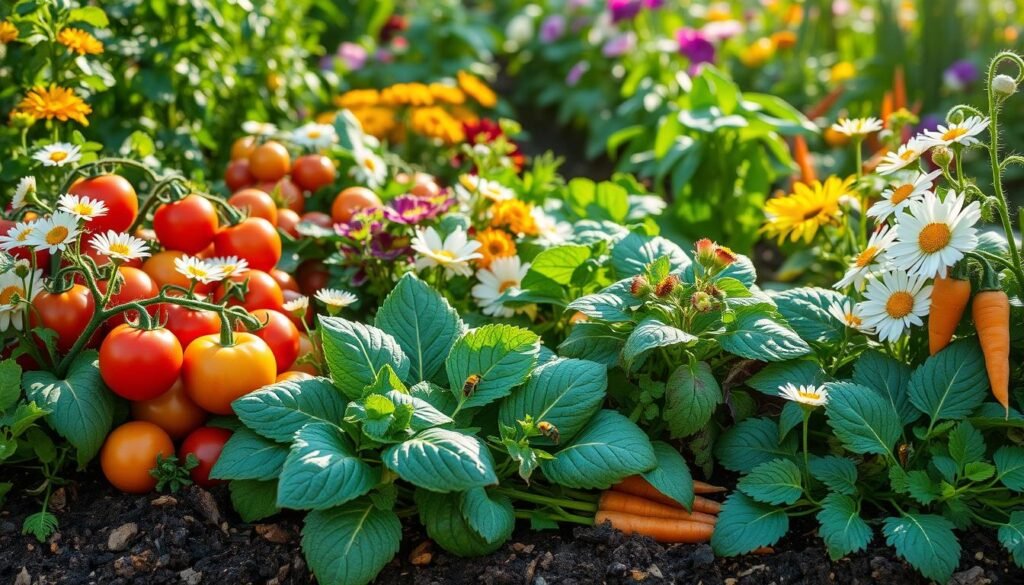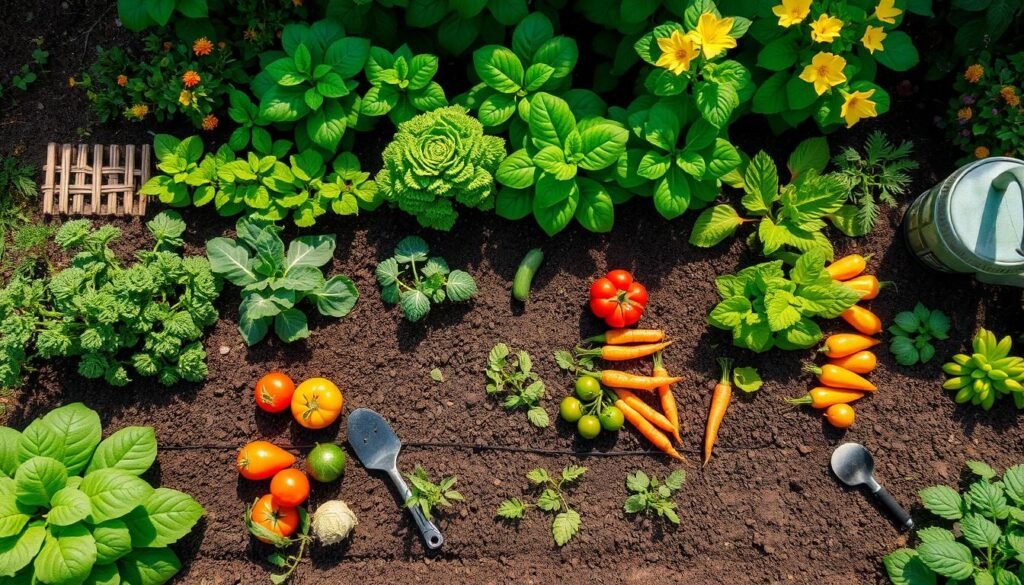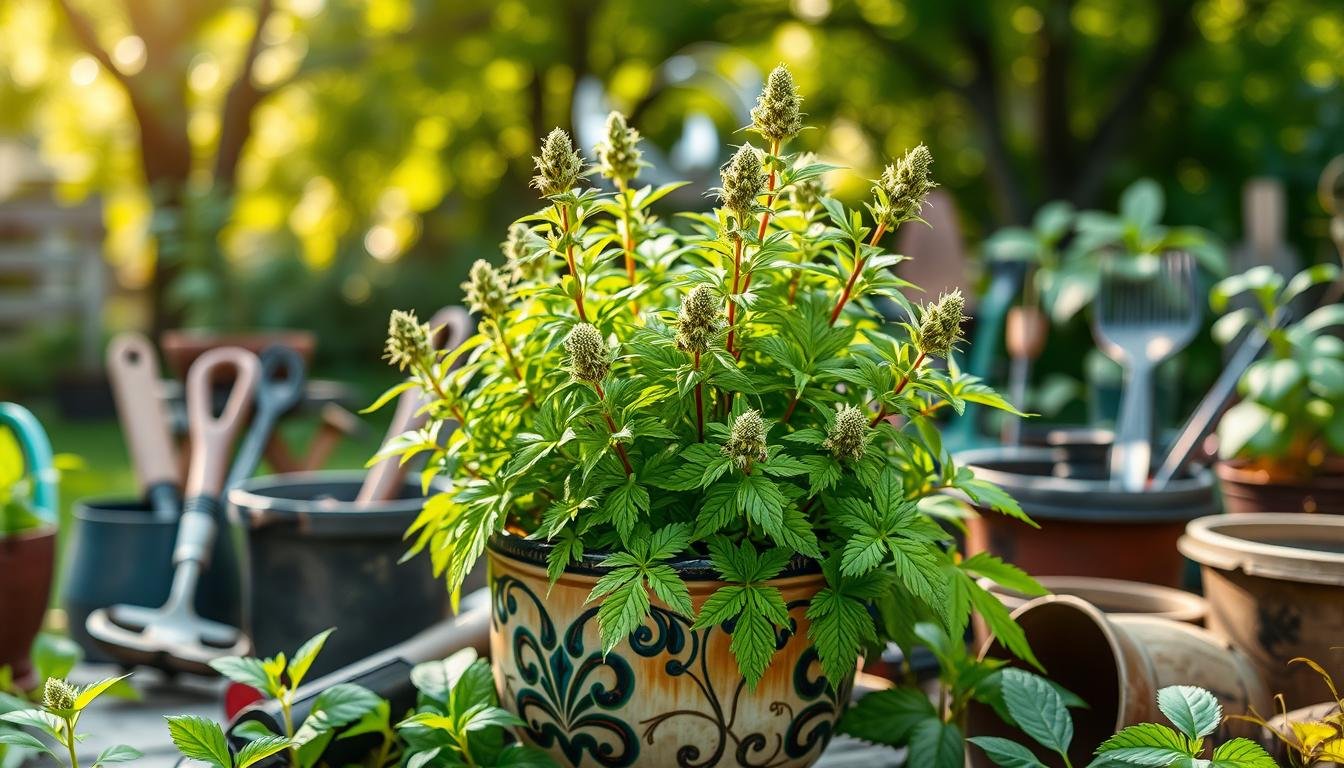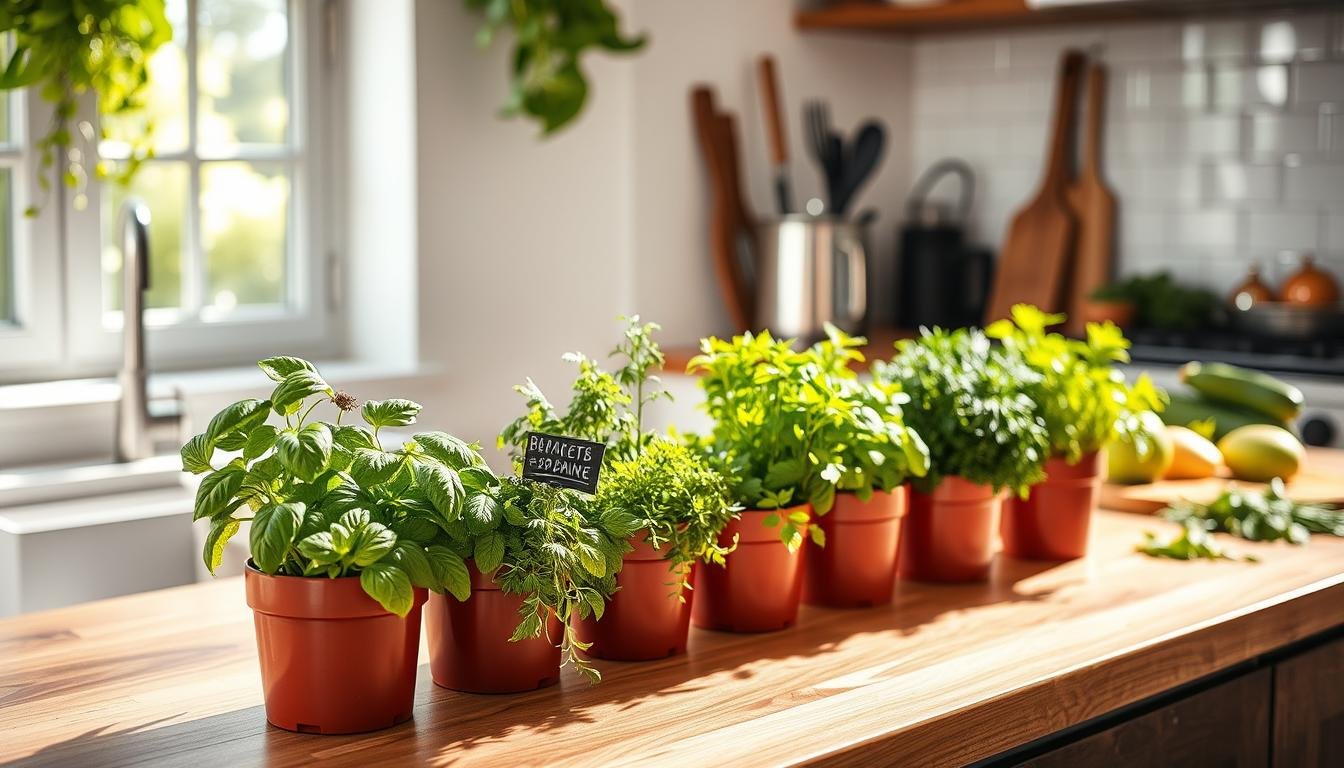About 80% of Americans feel that growing their own vegetables is rewarding. Starting a vegetable garden is practical and fulfilling, especially for beginners. Luckily, this guide is here to help you learn vegetable gardening basics. It will show you how to create a green oasis at home.
Through this guide, you’ll learn the benefits of growing your own food. These include better flavor and more nutrients, saving money, and the joy of connecting with nature. So, roll up your sleeves. Let’s jump into the amazing world of vegetable gardening!
Key Takeaways
- Vegetable gardening is accessible for beginners and can be a rewarding experience.
- Growing your own fruits and veggies offers numerous health benefits.
- Homegrown produce often tastes better than store-bought options.
- Cultivating a garden can save you money on groceries.
- Vegetable gardening fosters a connection with nature and the environment.
- Proper planning and knowledge are essential for a successful garden.
Understanding the Basics of Vegetable Gardening
Starting a vegetable garden is an exciting adventure. It’s key to learn the basics early on. This knowledge includes the various gardening methods like in-ground, raised beds, and container gardening. These methods help beginners succeed in their green endeavors.
In-ground gardening works well for large plants because it allows deep roots. Raised beds are great as they provide better drainage and warmth, making them perfect for cooler areas. For those with limited space, like apartment residents, container gardening is ideal. It lets you garden on balconies or small areas.
It’s helpful to know some important gardening terms. Words like compost, mulch, and crop rotation are key to gardening success. Also, your local climate greatly influences what plants you can grow. Knowing your climate zone sets you up for a good harvest.
Different soil types can affect your garden’s success. Sandy, clay, and loamy soils each have their own impacts on plants. Loamy soil is best for growing vegetables as it’s rich in nutrients. For beginners, choosing the right plants and improving your soil is crucial. Testing your soil can guide you on what will grow best, helping your garden thrive.
The Benefits of Growing Your Own Vegetables
Growing vegetables at home brings many perks, including fresh produce. One main benefit of growing vegetables is having healthy food at your fingertips. Veggies from your garden are fresher and tastier than those from the store. This makes meals healthier and encourages good eating habits.
Gardening keeps you active. Planting, weeding, and picking veggies gets you moving. This fights off a sedentary lifestyle, keeping you physically healthy. It’s hard work but greatly boosts your health benefits of gardening.
Gardening also helps your wallet. By growing veggies at home, you spend less on groceries. This shows the financial benefits of growing vegetables. It’s a smart way to save money.
There are environmental perks too. Environmental benefits of home gardening include reducing your carbon footprint. This happens because you cut down on the need for transportation and packaging. Plus, gardening at home uses fewer chemicals and helps the local wildlife.
There’s joy in seeing plants grow. Watching seeds turn into plants brings a deep sense of pride. This hobby can also be a peaceful break from daily stress. It adds emotional benefits to the many reasons for starting a vegetable garden.

| Benefits | Description |
|---|---|
| Health Benefits | Access to fresh, nutritious produce which promotes a healthier diet. |
| Economic Savings | Reduced grocery bills by growing your own vegetables at home. |
| Environmental Impact | Lower carbon footprint due to less transportation and packaging needed. |
| Physical Fitness | Gardening activities promote movement and physical health. |
| Mental Well-being | Cultivating plants provides stress relief and joy. |
How to Start a Vegetable Garden From Scratch
Starting a vegetable garden from scratch is an exciting journey. First, choose the right spot. It should get a lot of sunlight, around six hours daily. Make sure it’s easy to get to for watering and care. Having a water source nearby is also key.
Planning your garden’s layout is your next step. Sketch out where each plant will go. This helps use space wisely and makes rotating crops easier. Put plants with similar needs together to make gardening simpler.
For newcomers, creating a planting calendar is crucial. It tells you the best time to plant and harvest based on your area’s weather. Use it to track when to plant, when to expect to harvest, and care tasks. Good planning makes your garden more fruitful.
To help your garden thrive, remember these tips:
- Start with vegetables that are simple to grow, like tomatoes, lettuce, and radishes.
- Be patient and learn from any gardening errors; it’s all part of the experience.
- Keep an eye on your plants and update how you take care of them as needed.
Preparing Soil for Vegetable Gardens
Soil health is crucial for a good vegetable garden. It’s important to know what your plants need. First, test the soil’s pH. Most vegetables grow best in a pH range of 6.0 to 7.0. You can find test kits at garden centers.
Improving the soil structure can boost plant growth. The best soil has compost, peat moss, or old manure. These add nutrients and help with air and water in the soil.
When fixing garden soil, use the right amendments. For sandy soil, add clay to hold moisture. For clay soil, mix in sand or organic material to help water drain.
Mulching helps keep the soil at the right temperature and moisture level. It also stops weeds. Use organic mulches like grass clippings or shredded leaves. They feed the soil as they break down.
Composting gives the soil important nutrients. You can make compost with kitchen scraps and yard waste. This is good for your garden and the planet.

| Soil Type | Characteristics | How to Amend |
|---|---|---|
| Sandy Soil | Drains quickly, lacks nutrients | Add organic matter and clay |
| Clay Soil | Packs tightly, retains water | Incorporate sand and compost |
| Loamy Soil | Ideal for most vegetables | Maintain with compost and mulch |
| Silty Soil | Good nutrients, holds moisture | Add organic matter for aeration |
Knowing how to prepare soil is key to a great garden. This work means healthy plants and big harvests in your future.
Choosing the Right Vegetables for Beginners
Starting a garden is exciting, especially for beginners. The key is to pick the right vegetables that ensure success. Beginners should choose veggies that are not only easy to grow but also rewarding. It’s important to know which vegetables grow well for a great start.
When choosing vegetables, consider these points:
- Growth Habit: Go for veggies that are low-maintenance. For instance, radishes and lettuce don’t need much and grow quickly.
- Planting Time: Learn the best times to plant. Some veggies do best in early spring or late summer.
- Compatibility: Some plants grow better together. Like cucumbers do well with the shade from taller plants like tomatoes.
| Vegetable | Days to Maturity | Growing Conditions |
|---|---|---|
| Radishes | 25-30 days | Full sun, well-drained soil |
| Lettuce | 30-60 days | Partial to full sun, moist soil |
| Cucumbers | 50-70 days | Full sun, fertile soil |
| Carrots | 70-80 days | Full sun, loose soil |
By following these tips and choosing the right veggies, beginners will find gardening more fulfilling. Have realistic goals and enjoy growing your own food. It’s a rewarding journey that starts with easy steps!
Essential Garden Tools for Beginners
Starting a vegetable garden is an exciting journey. The right tools make all the difference. Knowing the essential tools helps beginners streamline their gardening process. It’s smart to start with a few key tools and grow your collection as your skills improve.
Here’s a list of basic gardening supplies every beginner gardener should have:
- Trowel: A small hand tool used for digging holes and transplanting seedlings.
- Weeding Fork: Great for loosening soil and removing pesky weeds.
- Gloves: Protect your hands while working in the garden. Choose breathable materials for comfort.
- Watering Can: Essential for keeping your plants hydrated, especially when they’re young.
- Pruning Shears: Helpful for cutting back overgrown plants and shaping them.
These tools are must-have gardening tools for taking proper care of your vegetable garden. When buying these items, think about checking out local garden centers or trustworthy online shops. This can lead to good deals without giving up on quality. Plus, as you get more into gardening, you might find more specific tools for your needs.
| Tool | Function | Price Range |
|---|---|---|
| Trowel | Digging and transplanting | $10 – $25 |
| Weeding Fork | Weed removal and soil loosening | $8 – $20 |
| Gloves | Hand protection | $5 – $15 |
| Watering Can | Watering plants | $10 – $30 |
| Pruning Shears | Trimming plants | $15 – $40 |
Planting Your Vegetable Seeds and Transplants
Knowing how to plant correctly is key for a great garden. Using the best seed planting methods can really help your plants grow. First, pick high-quality seeds that fit your climate. Each seed type needs a certain depth and space to grow well. Usually, it’s best to plant them two to three times their diameter deep.
Choosing the right time to move seedlings outside is important. Make sure to check when the last frost happens in your area. Before moving them out, you should get them used to the outside. This means placing them outside for a bit each day, slowly increasing the time over a week.
When it’s time to plant your seedlings, here are some tips for good growth:
- Loosen the soil and mix in some compost before planting.
- Give each plant enough room to grow, considering their needs for air and sunlight.
- Water the seedlings well before and after moving them to help them settle.
To get the best growth, water your plants regularly right after planting. Doing this helps your seeds and seedlings build a strong base for future growth.
Watering and Fertilizing Your Vegetable Garden
Watering your vegetable garden properly is very important. Deep watering helps roots grow deep, making plants stronger. It helps the soil keep moisture and stops water from evaporating too quickly. Drip irrigation is another good method. It slowly waters the roots, ensuring the soil stays evenly moist.
Choosing the right fertilizer is key to growing healthy vegetables. Organic options, like compost tea or aged manure, are great. They add important nutrients to the soil safely, without harsh chemicals. This is better for you and the environment.
When planning your fertilization, keep these tips in mind:
- Apply fertilizers during the growing season for best results.
- Test your soil to know what nutrients it needs.
- Use a mix of nutrients to meet different plant needs.
Using these watering methods and choosing the right fertilizers will help your garden thrive. Your vegetables will be more plentiful and healthier, leading to a great harvest.
Pest Management in Vegetable Gardening
Pest control is key for keeping vegetable gardens healthy and fruitful. It starts with knowing the pests and diseases that can hurt your crops. Aphids, beetles, and caterpillars are common enemies. They can damage leaves and fruits. Spotting and knowing these pests early is important for control.
Integrated Pest Management (IPM) uses different methods for controlling pests. This approach favors the environment while keeping your plants safe. It includes using helpful insects like ladybugs, which eat harmful pests. This natural defense reduces the need for chemicals.
Here are some top tips to prevent pests:
- Rotate crops every year to stop pest cycles.
- Clear away debris and weeds where pests live.
- Use covers to shield young plants.
- Grow a variety of crops to support biodiversity.
Using these steps, you can create a garden that resists pests. This keeps your vegetable garden thriving.
| Pest | Symptoms | Control Methods |
|---|---|---|
| Aphids | Wilting leaves, sticky residue | Introduce ladybugs, use insecticidal soap |
| Spider Mites | Webbing, yellow spots on leaves | Increase humidity, apply neem oil |
| Tomato Hornworm | Defoliation, visible caterpillars | Handpick, use Bacillus thuringiensis |
| Cabbage Worms | Holes in leaves, droppings | Cover with row covers, use organic pesticides |
By applying these strategies, your garden will have effective pest control. This means healthier plants and more produce in the long run.
Harvesting and Enjoying Your Vegetables
After working hard on your vegetable garden, it’s finally time to enjoy the rewards. Harvesting vegetables the right way ensures you get the most flavor and their best shelf-life. For example, it’s best to pick vegetables like tomatoes and zucchinis when they’re just right – mature yet still firm.
Understanding how to harvest correctly can really bring out their taste and nutritional benefits. Once you’ve picked your vegetables, it’s crucial to store them properly. Leafy greens should go in the fridge and can stay fresh for several days. On the other hand, root veggies like carrots and potatoes last longer in a cool, dark spot.
Proper storage helps your homegrown produce last longer, extending the joy of your harvest. And don’t forget the fun part – eating them! Get creative with cooking and try out new recipes that make your vegetables shine. Whether it’s fresh salads full of color or warm, hearty soups, the options are limitless.
Enjoying the vegetables from your garden is rewarding. It underscores your hard work and can even inspire your next garden project. Every season can bring new delights and successes, making gardening a truly gratifying hobby.



